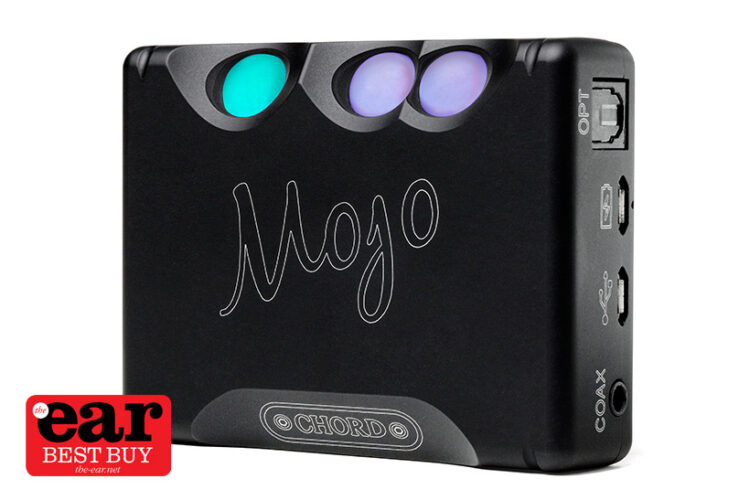The Mojo is something of a radical move for Chord Electronics, the brand has long been associated with high end audio separates which tend to carry a high end price. The Hugo portable DAC/headphone amp brought the entry level down quite considerably but still kept it within the realm of dedicated enthusiasts, anyone else would think that £1,400 for a DAC to go with your phone is madness, if they knew what a DAC was. But the success of competitors like Astell & Kern and others in bringing high end portable players to market must have spurred Chord’s MD John Franks into thinking that if he could make something small enough that was not too expensive there just might be a market for it. The Mojo at £399 has to be among the least expensive pieces of British built audio equipment on the market, it is undoubtedly the smallest and yet it is also among the most technologically advanced. Mojo will support sample rates up to an eye watering 768kHz via both its USB and coaxial inputs, and word lengths up to 32-bit. DSD up to 4x or DSD256 can be handled using DoP (DSD over PCM). Figures which exceed the capabilities of all but the most extreme portable, and for that matter domestic, sources, but it’s nice to be future proofed.
All this in a machined aluminium case that is literally no bigger than a fag packet, making it considerably more portable than a Hugo and most other mobile DACs to boot. It is said to be capable of driving any headphone with an impedance between four and 800 Ohms albeit no reference is made to actual sensitivity. It has two headphone outputs which like all the other connections are on minijacks, this means you need a mini coax to RCA for if you want to use it with your CD player or any other domestic digital transport, the Toslink input is the only standard connection on the case. Luckily micro USB connectors are relatively common on phone charging cables now so most of us will have such a connection if the very short one in the box is inconvenient. Mojo’s technological advances are the work of long time Chord ally Rob Watts, one time founder of Deltec (DPM) and all round digital whizz. Find out more about the technology behind Mojo in our interview with Rob.

Functionality on Mojo is a major step forward over Hugo, basically it’s plug and play with no need to fiddle with tiny switches or read legends, whatever is connected will be played. The USB input takes priority in situations where there is more than one source so it just needs disconnecting when using coax or optical. And given that Mojo was designed to be used with mobile phones the likelihood is that most users will connect via USB anyhow. To do this you need an OTG or on the go USB cable with a micro USB at both ends or one that converts the iPhone’s Lightning connector to USB. I did most of my listening with a full system and used very basic USB cable for input with a variety of alternatives on the output.
Controls on Mojo extend to on/off and volume, this done with acrylic balls that glow in different colours to indicate status. Once you get to grips with the colours you can tell how high the volume is or alternatively whether you have succeeded in bypassing it and inducing full signal line out. The colour of the power button indicates sample rate with red being equivalent to the red book CD standard 44.1kHz and white for DSD at the other end of the spectrum.

One of the more challenging aspects about building a DAC this size that has an FPGA and headphone amp onboard is power, lithium ion batteries are remarkably powerful but are not all that happy operating at high temperatures. You will have heard your laptop’s cooling fans kick in on the occasions that the thing has actually been on your lap no doubt. Mojo has the latest high temperature battery tech so that it can cope with its cramped conditions and a claimed charge time of four hours and play time of 10 hours. Which is good enough for home use, especially if you remember to turn it off after the session!
My excuse was that the Mojo was hidden from view on its very short USB cable sitting on top of the Melco N1-A, this server proved a very nice match for the DAC which delivered better results via USB than coax. The Mojo is a remarkably revealing and articulate DAC by any standards let alone given its price, it produces a meaty, powerful double bass in a stereo image that’s strong on solidity and spaciousness, it’s clearly too good for mobile phones! Herbie Hancock’s ‘yodelling’ during the solo on Summertime (Gershwin’s World, Decca) has a distinct echo that marks out the size of the room and the nature of the recording. The space is likely a result of transient speed that Rob Watts says is the benefit of having more taps in the DAC (see interview). The converter’s ability to stop and start with minimal time smear means that notes are not blurred over one another but rather that there are gaps between for the room acoustic to make its mark.
I really enjoyed the way that ZZ Top’s ‘Enjoy And Get It On’ (Tejas, Warner Bros) chugged along and was impressed by the expansive nature of the imaging. It’s hard to say whether this is the Mojo exaggerating the scale of imaging or it being very revealing in this respect but either way it made for engaging entertainment. Rob Watts mentioned that he had tuned the analogue output for a smoother sound in order to accommodate less pristine sources and this is apparent in a slight warmth to the balance that does little or nothing to undermine the DAC’s potential to entertain. It just means you don’t get quite the transparency of the very best in this regard, it makes me wonder what the Dave DAC that Chord has just released for domestic systems can do, it should be at least as good as this after all.

I really got into the speed that this DAC offers, it makes almost anything that’s dense and pacey sound more exciting and real, be it drums, guitars, voices or everything at the same time. Under these circumstances the lack of smear, the precision makes the music incredibly coherent, and this is probably more true of lesser recordings than the pristine ones. It’s easy to make Shelby Lynn sound good because it’s so simple but Frank Zappa’s ‘Magic Fingers’ (You Can’t Do That On Stage Anymore Volume 6, Zappa) played live by a large band is another kettle of mudsharks. It inspired me to play the dark and demanding ‘The Ocean Is The Ultimate Solution’ (Sleep Dirt, Zappa) which offered up Terry Bozzio’s drumming so clearly and precisely that I got carried away and couldn’t turn it off.
In an attempt to get down to earth I played some high res, starting with Ryan Adams’ Gold on DSD, this offered up a massive soundstage and a very natural, almost analogue balance, sounding like an early seventies Faces recording. I also tried this with a Chord Clearway minijack coax to RCA between a Moon Mind streamer and the Mojo, compared to the USB connection it produced a warmer and rounder result that made for more relaxed but ultimately less engaging sound. In some systems this might be a better solution but the precision of the USB connection suited the slightly smooth sound of the Mojo rather better in mine.
I also tried some mainstream music in the form of a DSD version of ‘Rolling In The Deep’ (Adele, 21, XL), a track with phenomenal vocals but horrible compression on the chorus, that is usually the point at which I press stop, here however the sound while hardly sweet didn’t get so messy and meant it was possible to enjoy the whole song.
The Mojo is a remarkable achievement for any company let alone one of Chord’s size, I suspect that it could change that aspect of things quite significantly once the non audiophile world comes to terms with accessorising their phones to this extent. But even if you don’t want to listen on the move it’s a remarkable converter, I highly recommend giving it a try whatever your digital source, you will be pleasantly surprised both by the sound it produces and the quality of the Mojo, it’s a lovely gadget in more ways than one.


